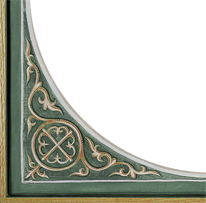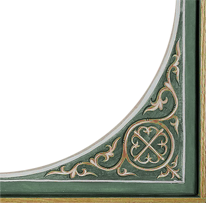The Divine Services of the Orthodox Church Matins - 2
We will continue today our exploration of the Divine Services of the Orthodox Church. Last time, we were speaking about the Matins service, the morning service that greets the dawning of the light of day and expresses the joy of the greeting of the coming of Jesus Christ our Savior.
We concluded last time with the Kathismata – the Psalm readings that foreshadow the sufferings of Christ. We come now to the Polyeloeos and Evlogitaria, which, in many ways, begins the ‘highlight’ of the Matins service. The Evlogitaria verses comes from the Greek word meaning ‘Blessed’… the refrain we hear repeated is ‘Blessed are Thou O Lord, teach me Thy statutes’. For services of a certain rank, the ‘Polyeleos’ verses are also sung… Polyeleos is a Greek word meaning ‘many mercies’ or ‘plenteous in mercy’. The Royal Doors are opened, the lights are illumined, and we sing the triumphant verses from Psalms 134 and 135, ‘Praise ye the name of the Lord; O ye servants, praise the Lord. O give thanks unto the Lord, for He is good, for His mercy endureth forever. Alleluia.’ While these joyful verses are being sung, the priest (preceded by the deacon) does a full censing of the church – first censing the altar and then coming out to cense the iconostasis, the people, and then going around the full perimeter of the church to cense each icon and each person present.
With the Matins service, we are now fully involved in the morning services of Sunday, the day of Christ’s resurrection. Archpriest Victor Potapov, who I have turned to frequently in this series of sermons on the Vigil service, tells us this: ‘Through these liturgical actions, the faithful witness the events of the Resurrection. In the opening of the Beautiful Gates, they see how Christ rose from the tomb; and in the clergy procession from the altar to the center of the church, they see how He again appeared among His disciples. While this is taking place, the psalm, ‘Praise ye the Lord’, continues to be chanted, together with the angelic refrain, ‘Alleluia’; it is as if the choir is acting on behalf of the angels, calling the faithful to praise the Risen Lord.’
After the chanting of these verses, special Resurrection Troparia are sung – describing how the angels appeared to the myrrh-bearing women to proclaim the good news of the resurrection of Christ. On special feast days, or days where a particularly venerated saint is to be commemorated, the clergy gather in the center of the church before the icon of the feast or saint to sing the Magnification – a special hymn of praise and honor to the feast or saint being celebrated.
Following the Magnification (if there is one sung) we have the Small Ektenia (‘Again and again, in peace let us pray to the Lord…’) and then we move into the ‘Hymns of Ascent’. The Hymns of Ascent are meant to be sung antiphonally – that is with one choir on the right and one choir on the left, alternately singing one verse after another. This liturgical practice is very ancient and comes from the Old Testament worship done at the steps of the Temple in Jerusalem. Two choirs faced toward each other on the steps that ascended into the Temple – this is why these verses are known as the Hymns of Ascent.
Now we come to the preparation for the reading of the Holy Gospel. The Orthodox Church holds Holy Scripture in great honor and realizes that our mind and soul must be spiritually ‘warmed up’ to hear with proper attention and reverence the words of Holy Scripture. We have censed the entire church and all those present – elevating the atmosphere within the church to let our prayers rise up like the incense. We have glorified God with the joyful singing of the Polyeleos and the Hymns of Ascent. The deacon or priest now calls out ‘Let us attend. Wisdom. Let us attend.’ and he then proclaims the Prokeimenon in the tone of the week. Prokeimenon, as you may recall from our study of the Vespers service, means ‘principle’ or ‘foremost’ - given to the short verses expressing the essence of the feast being celebrated. Following the Prokeimenon, the priest or deacon exchanges a series of praises with the choir, saying: ‘Let every breath praise the Lord…’. We pray that we may be deemed worthy to hear the Holy Gospel and a blessing of peace is bestowed by the priest, to which the congregation responds that peace may also be with his spirit. Peace and reverence are the prerequisites for us to approach and hear the Holy Gospel.
The Holy Gospel is then read by the priest. There are 11 ‘Sunday Resurrection Gospel’ passages that are read in an ongoing weekly cycle throughout the year. These ‘Resurrection Gospels’ are taken from the four Gospel books and highlight those verses that speak of Christ’s resurrection and His ministry after He had risen from the dead and before His ascension into heaven.
On most Sundays, the Gospel is read by the priest from within the altar. The altar represents the tomb of Christ and there is great significance in hearing the joyful news of Christ’s resurrection coming from the tomb. It is the source of a Christian’s hope and joy that Christ our God has overcome death and the tomb, and we must listen to the Resurrection Gospel with attention, gratitude, and joy.
The Polyeleos, the Magnification to the feast or saint, and the reading of the bright Resurrection Gospel are the high points of the Matins service. It is in these beautiful Vigil services that we are most clearly instructed on the meaning of the day we are celebrating. The Divine Liturgy, which will be celebrated on Sunday morning, while it contains the special troparion and kontakion verses to the feast or saint, is focused rather on the great and holy Mystery of the coming of Christ to us in the consecration of the Holy Gifts and the encounter with our Lord in Holy Communion. Our celebration of the Sunday Resurrection and of the feast or saint being commemorated is most clearly expressed in the Vigil services and our celebration is not complete unless we participate in the wonderful Vigil service.
As we conclude our study of the Matins service next week, I encourage all of you to make the extra effort to attend the Saturday evening Vigil services. Attending and participating in these beautiful and enriching services brings to us the fullness of our Orthodox teaching and worship. May God bless these efforts and may each of us take advantage of the Church’s holy services to the edification of our souls and to the glory of our beloved God and Savior, Jesus Christ.
|
| |||||||||||||




